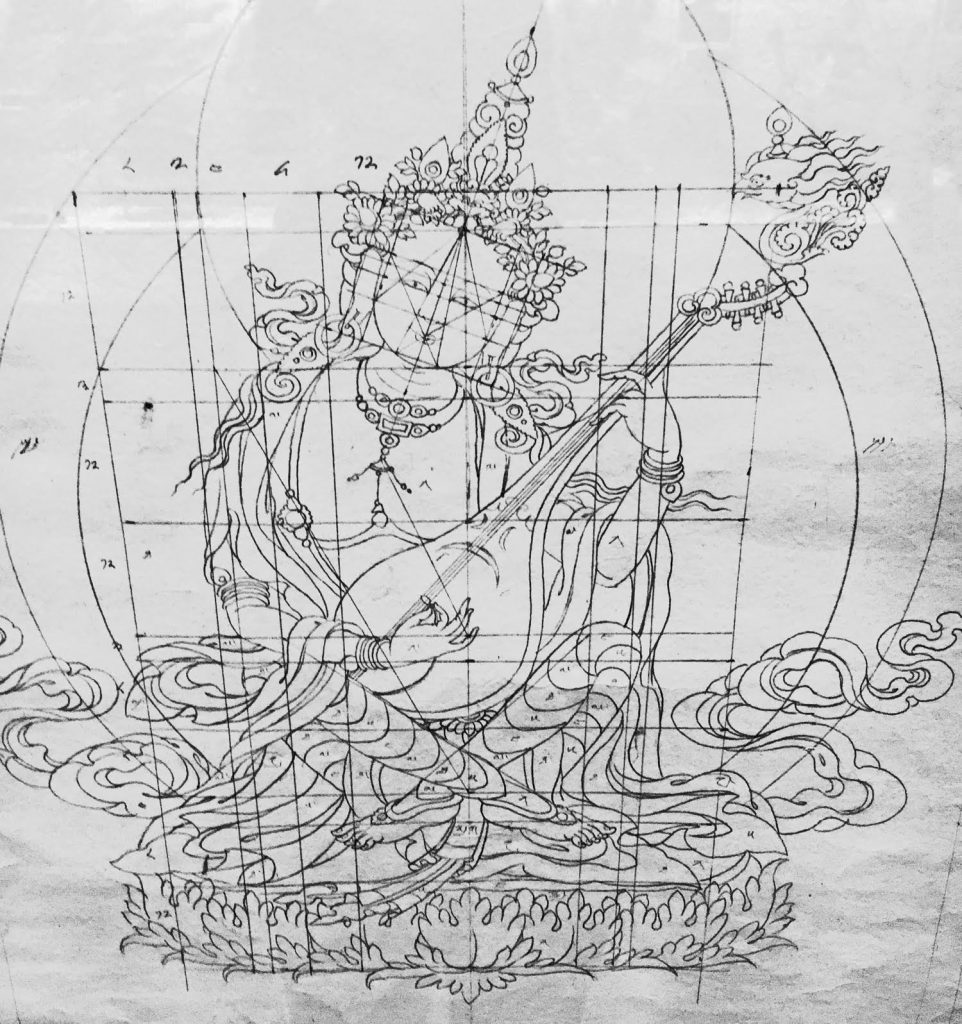This series began last week with Part One: Ritual in Preparing the Space/It’s the Simple Things – now we are drawn deeper into the museum and into a new process meditation.
—————————————————————————————————
My last stop at The Rubin Museum of Art was the exhibit Gateway to Himalayan Art. What immediately drew my attention were 4 pieces showing the stages of a thangka (scroll) painting. Thangka paintings most often depict deities or mandalas and are used in meditation practice. The paintings are not an expression of an individual artist; they are made by following a strict set of rules. Underneath the forms and colors is a complex grid based on precise measurements according to which deity is being depicted. In the process pieces at the Rubin, areas of the underlying grid of sacred geometry are left visible.

I love seeing works in progress or unfinished artwork–a chance to spy the secrets that lie underneath the surface. But also, look at that grid! Yes, it’s true I am a student of Frank Santoro and, no, I am not going to go deep into practical and/or theoretical grid-talk. If you want that, get it from the man himself (the comments section is full of gems, too). If you prefer having your information in hard copy, it’s available that way, also.
As a person who has spent many+ hours drawing and re-drawing and drawing again the grid, it was an easy jump in my mind from this:

to this:

—————————————————————————————————
Part 2: Meditation on the Grid/Free Your Mind
Recently I was in the audience at a panel discussion where someone asked the artists about ‘creative block’ and how to over-come it. The answers ranged from ‘just getting off of the couch’ to knowing that there are ups and downs in creative work. If I might add my own answer to the question no one asked me:
Sometimes my mind is unwell, or full of complicated messy things or unable to think of new ideas (‘creative block’, I guess?). When I am in this state, I let my wild, creative mind rest. One way to do this is by going into a gentle analytical and physical practice. I sit down at my desk and pre-draw pages of panels and grids. Similar to preparing my workspace as mentioned in Part One, pre-drawing panels and grids is a simple concentration-meditation that doesn’t require much thought (common theme: freedom from the mind!). I get out my ruler, triangle and compass and start to push my pencil across the page making the prescribed lines. I am not inventing them. There is a formula and I’m following that formula.
In my comics, I almost exclusively use a four-panel grid. Through years of repetition comes ease and comfort in getting to a single-pointed mind-concentration. In this concentration I’m not working out story ideas or fixing problems. I’m just there, holding the pencil in my hand, running it along the ruler. On certain days I’ve ended up with a stack of 20 pages of panels with varying elements of the grid or sometimes a single page with different color lines on top of lines on top of lines… It is an easy practice that is calming and allows some space to open up. And at the end of the practice, as an added bonus to a relaxed mind, I have pages at the ready for the days when the last thing I want do is draw a straight line.
—————————————————————————————————
Look for Part 3 of this ongoing series next week!
—————————————————————————————————
Alyssa Berg makes comics in Brooklyn, NY. You can find her work HERE.

Your mentality on panel making reminds me of this quote by writer Haruki Murakami on repetition, “When I’m in writing mode for a novel, I get up at 4:00 am and work for five to six hours. In the afternoon, I run for 10km or swim for 1500m (or do both), then I read a bit and listen to some music. I go to bed at 9:00 pm. I keep to this routine every day without variation. The repetition itself becomes the important thing; it’s a form of mesmerism. I mesmerize myself to reach a deeper state of mind. But to hold to such repetition for so long — six months to a year — requires a good amount of mental and physical strength. In that sense, writing a long novel is like survival training. Physical strength is as necessary as artistic sensitivity.”
I think comic writers are constantly running a marathon which makes them some of the steeliest people I can think of.